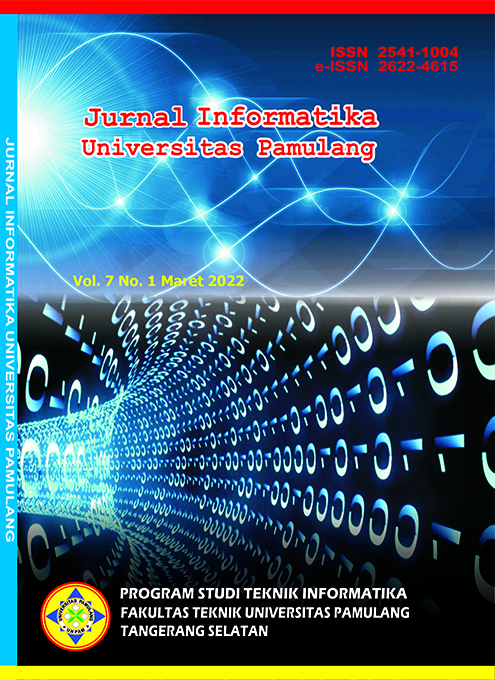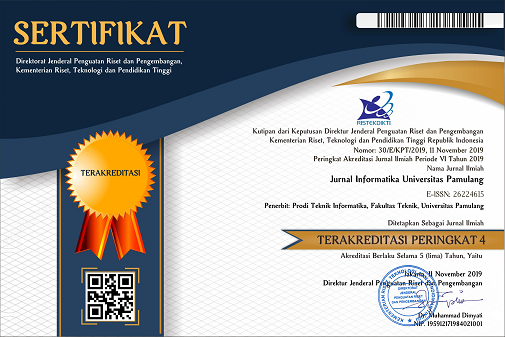Perbandingan Algoritma Klasifikasi Support Vector Machine dan Random Forest pada Prediksi Status Indeks Mitigasi dan Kesiapsiagaan Bencana (IMKB) Satuan Kerja BPS di Indonesia Tahun 2020
DOI:
https://doi.org/10.32493/informatika.v7i1.16117Keywords:
Classification, Support Vector Machine, Random Forest, Disaster Mitigation, Disaster Preparedness.Abstract
Natural and non-natural disasters are closely related to material and non-material losses. Government agencies are one of the important elements in disaster mitigation and preparedness efforts in order to reduce the number of victims and losses that will be caused. Disaster preparedness in the work unit is influenced by several factors, including regional characteristics, experience in disasters, education level, and employee conditions. This study aims to obtain a classification method that is able to predict the status of the Disaster Mitigation and Preparedness Index of work units based on several factors that affect disaster preparedness. Data processing uses the R Studio application with the Support Vector Machine (SVM) and Random Forest classification methods. Several studies have shown that the accuracy of the SVM and Random Forest classification methods tends to be better when compared to other classification methods. In addition, SVM is able to classify non-linear data and with Random Forest there will be no overfit as the number of trees increases. The results showed that the Random Forest classification method had higher accuracy, precision, and recall values than SVM with an accuracy value of 78.22%, precision of 75.54%, and recall of 76%.
References
Amalia, H. (2018). Perbandingan Metode Data Mining Svm Dan Nn Untuk Klasifikasi Penyakit Ginjal Kronis. Jurnal PILAR Nusa Mandiri, 14(1), 1–6.
Benson, C., & Twigg, J. (2007). Tools for Mainstreaming Disaster Risk Reduction: Guidance Notes for Development Organisations. In 2007.
Breiman, L. E. O. (2001). Random Forests. 5–32.
Han, J., & Kamber, M. (2006). Data Mining Concept and Technique. Elsevier.
Herdwiyanti, F., & Sudaryono. (2012). Perbedaan Kesiapsiagaan Menghadapi Bencana Ditinjau dari Tingkat Self-Efficacy pada Anak Usia Sekolah Dasar di Daerah Dampak Bencana Gunung Kelud. Jurnal Psikologi Kepribadian dan Sosial, 1(03).
Hidayat, D. (2008). Kesiapsiagaan Masyarakat: Paradigma Baru Pengelolaan Bencana Alam. Jurnal Kependudukan Indonesia, 3(1), 69–84. http://ejurnal.kependudukan.lipi.go.id/index.php/jki/article/view/164
Ismanto, E., & Novalia, M. (2021). Komparasi Kinerja Algoritma C4 . 5 , Random Forest , dan Gradient Boosting untuk Klasifikasi Komoditas. Techno.COM, 20(3), 400–410.
Octaviani, P. A., Wilandari, Y., & Ispriyanti, D. (2014). Penerapan Metode Klasifikasi Support Vector Machine (Svm) Pada Data Akreditasi Sekolah Dasar. JURNAL GAUSSIAN, 3, 811–820.
Pamuji, F. Y., & Ramadhan, V. P. (2021). Komparasi Algoritma Random Forest Dan Decision Tree Untuk Memprediksi Keberhasilan Immunotheraphy. Jurnal Teknologi dan Manajemen Informatika, 7(1), 46–50.
Rachman, F., & Purnami, S. W. (2012). Perbandingan Klasifikasi Tingkat Keganasan Breast Cancer Dengan Menggunakan Regresi Logistik Ordinal Dan Support Vector Machine ( SVM ). Jurnal Sains dan Seni ITS, 1(1).
Rustam, R. (2018). Kerjasama Pemerintah Dan Masyarakat Dalam Penanggulangan Bencana Di Kabupaten Luwu Utara. Skripsi.
Swiss Re. (1998). Floods - an insurable risk? : a market survey. In Swiss Reinsurance Company.
Wijaya, S. A., Wulandari, Y., & Lestari, R. I. (2019). Faktor-Faktor Yang Mempengaruhi Kesiapsiagaan Bencana Gempa Bumi Padalansia di Posyandu Pun- todewo Tanjungsari Surabaya. Jurnal Keperawatan Muhammadiyah, 4(1).
Zhao, Y. (2015). R and Data Mining : Examples and Case Studies. December 2012.
Downloads
Published
Issue
Section
License
Authors who publish with this journal agree to the following terms:
- Authors retain copyright and grant the journal right of first publication with the work simultaneously licensed under a Creative Commons Attribution-NonCommercial 4.0 International (CC BY-NC 4.0) that allows others to share the work with an acknowledgement of the work's authorship and initial publication in this journal.
- Authors are able to enter into separate, additional contractual arrangements for the non-exclusive distribution of the journal's published version of the work (e.g., post it to an institutional repository or publish it in a book), with an acknowledgement of its initial publication in this journal.
- Authors are permitted and encouraged to post their work online (e.g., in institutional repositories or on their website) prior to and during the submission process, as it can lead to productive exchanges, as well as earlier and greater citation of published work (See The Effect of Open Access).
Jurnal Informatika Universitas Pamulang have CC-BY-NC or an equivalent license as the optimal license for the publication, distribution, use, and reuse of scholarly work.
In developing strategy and setting priorities, Jurnal Informatika Universitas Pamulang recognize that free access is better than priced access, libre access is better than free access, and libre under CC-BY-NC or the equivalent is better than libre under more restrictive open licenses. We should achieve what we can when we can. We should not delay achieving free in order to achieve libre, and we should not stop with free when we can achieve libre.
Jurnal Informatika Universitas Pamulang is licensed under a Creative Commons Attribution-NonCommercial 4.0 International (CC BY-NC 4.0)
YOU ARE FREE TO:
- Share : copy and redistribute the material in any medium or format
- Adapt : remix, transform, and build upon the material for any purpose, even commercially.
- The licensor cannot revoke these freedoms as long as you follow the license terms





